
 |
Tea Clipper |
 |
| from TeaAntiques.com | ||
| Edition Twenty Nine |
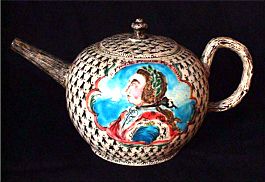
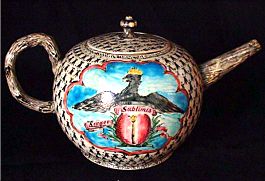
A very rare and extremely decorative Staffordshire salt-glazed teapot and cover commemoration Frederick the Great, King of Prussia, made in Staffordshire, c1760. The teapot is painted with a portrait of Frederick the Great and inscribed 'Fred III Prussae Rex' on one side, and painted with the Prussian eagle and inscribed 'Semper Sublimis' on the reverse. The teapot is also smothered with an ermine ground decoration, which is regal and extremely striking in appearance.
Frederick the Great, King of Prussia was a very popular figure in England in the late 1750s and early 1760s, the time from which this beautiful teapot dates. In 1756, Frederick established an alliance with England against Maria Theresa, France, Russia, Sweden and Saxony. This alliance had been formed at the start of the Seven Years' War, which raged through central Europe from 1756 to 1763. It was this war that effectively ended the reign of Meissen's stylistic influence on European designs after half a century of domination.
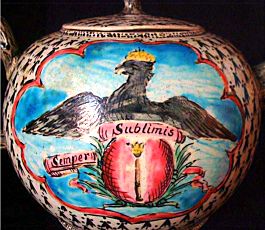
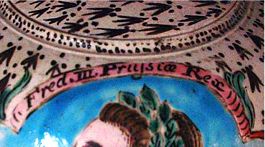
The decoration on this very rare teapot celebrates England's alliance with Frederick, showing the King's profile on one side and the Prussian Eagle on the other. The black and white ground decoration over the teapot depicts ermine, a reference to Royalty.
There is a charming and rustic 'crabstock' handle, painted with black lines along its moulded shape.
This is certainly a very rare and beautiful English Staffordshire, salt-glazed teapot dating from 1760. It is decorated commemorating Frederick III of Prussia, and thus has great historical significance. Not only a rare teapot, but one of historical importance. A magnificent piece for the collector of antique English salt-glazed ware.
More details of this item and other tea related antiques can be found by visiting my web site at www.TeaAntiques.com.
To see the latest items, click here.
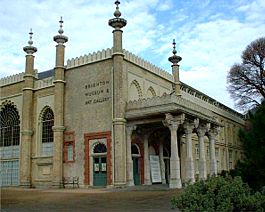 img src="teaclipperimages/Brighton/Brightonmuseum_28.jpg" style="float: right"width="265"
height="198"/>In the wonderful Regency city of Brighton, on the South Coast of England,
is an exciting newly refurbished museum and art gallery in which is a fabulous collection
of antique porcelain, including many exciting tea wares.
img src="teaclipperimages/Brighton/Brightonmuseum_28.jpg" style="float: right"width="265"
height="198"/>In the wonderful Regency city of Brighton, on the South Coast of England,
is an exciting newly refurbished museum and art gallery in which is a fabulous collection
of antique porcelain, including many exciting tea wares.
The museum and art gallery is conveniently situated near to the centre of town in the shadow of the famous Brighton Royal Pavilion, the extravagant pavilion of the Prince Regent, later King George IV. From the entrance to the museum, one can look back at the exotic skyline of the pavilion, its many minarets profiled against the sky.
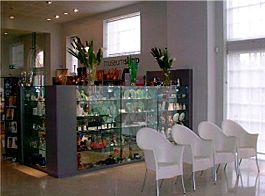
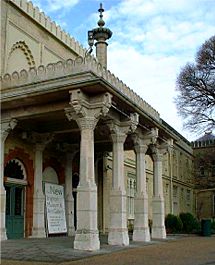 Like
the pavilion, the museum and art gallery is housed in a building with the same architectural
theme. Inside, the museum has recently received a massive new make over, with many
improvements. There is a very light and modern entrance foyer, with shop and help
reception.
Like
the pavilion, the museum and art gallery is housed in a building with the same architectural
theme. Inside, the museum has recently received a massive new make over, with many
improvements. There is a very light and modern entrance foyer, with shop and help
reception.
Housed in one large gallery is a very fine collection of early antique china and pottery. This impressive collection was the work of one man, Mr Willet 1823-1905. He amassed and documented the items into categories such as religion, political, sporting themes etc. there are 23 such groupings and the museum has now displayed the collection in the same groupings that were intended by Mr Willet. This has been beautifully achieved with fine new display cabinets, well lit, displayed and documented notes on every item - a true paradise for the lover of antique porcelain. For the lover of tea antiques there is certainly many exciting teapots, jugs etc. to be enjoyed.
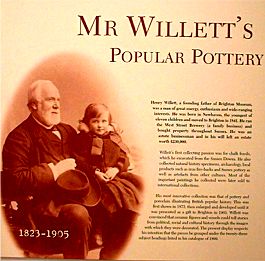
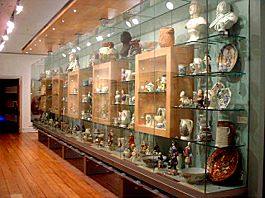 Henry
Willett was a founder of Brighton museum, a man with great enthusiasm towards collecting.
Born in Newhaven, the youngest of eleven children. He moved to Brighton in 1841,
a clever businessman who, on his death, left an estate of £230,000. He ran his family's
brewery business and also bought up properties within the Sussex area. His collecting
was wide and varied, from excavating fossils from the chalk Sussex Downs to natural
history specimens and local products. The collection of pottery and porcelain illustrates
British popular history. First exhibited in 1873, it grew and developed into a fine
collection that was presented to Brighton in 1903. Willett believed that the ceramic
figures and vessels could tell the story of political, social and cultural history
through the images portrayed on the items.
Henry
Willett was a founder of Brighton museum, a man with great enthusiasm towards collecting.
Born in Newhaven, the youngest of eleven children. He moved to Brighton in 1841,
a clever businessman who, on his death, left an estate of £230,000. He ran his family's
brewery business and also bought up properties within the Sussex area. His collecting
was wide and varied, from excavating fossils from the chalk Sussex Downs to natural
history specimens and local products. The collection of pottery and porcelain illustrates
British popular history. First exhibited in 1873, it grew and developed into a fine
collection that was presented to Brighton in 1903. Willett believed that the ceramic
figures and vessels could tell the story of political, social and cultural history
through the images portrayed on the items.
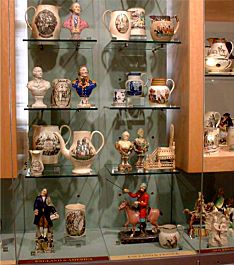
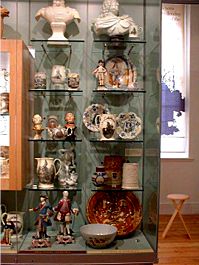
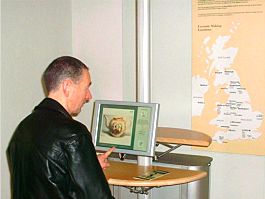
As part of the new display and layout there are some computer terminals in the exhibition room, designed to assist the visitor in their search or quest for information regarding the individual items within the collection. This system is easy to use, with touch screen instructions (even I could manage to use it!). To give you a flavour of the porcelain relating to tea within the collection, I have photographed some of the exhibits, which I hope that you will enjoy viewing too.
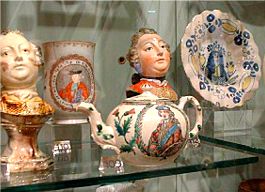
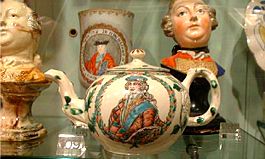 The
first exhibit to attract my attention, was this lovely teapot depicting the 'Bonnie
Prince Charlie'. The teapot is painted with a charming portrait of the Prince within
a cartouche. There are sprays of White English roses on one side of the portrait
and Scottish purple thistles on the other. There is a naturalistic crab stock shaped
handle and spout to the teapot.
The
first exhibit to attract my attention, was this lovely teapot depicting the 'Bonnie
Prince Charlie'. The teapot is painted with a charming portrait of the Prince within
a cartouche. There are sprays of White English roses on one side of the portrait
and Scottish purple thistles on the other. There is a naturalistic crab stock shaped
handle and spout to the teapot.
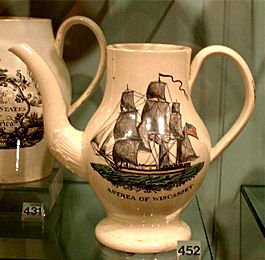
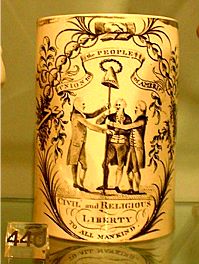 This
magnificent coffee pot, c1796 was probably made in Liverpool and is decorated with
enamels on Creamware. The decoration on one side is of the American ship 'Astrea
of Wiscasset' on the other side of the pot is a family scene.
This
magnificent coffee pot, c1796 was probably made in Liverpool and is decorated with
enamels on Creamware. The decoration on one side is of the American ship 'Astrea
of Wiscasset' on the other side of the pot is a family scene.
A Creamware mug, c1790, made in Staffordshire is beautifully decorated with three men, hands joined to support the Cap of Liberty. There is an inscription on a banner which says 'Union to the People of America'.
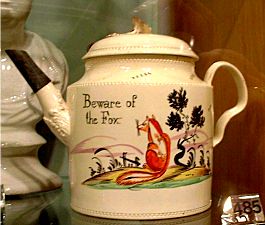
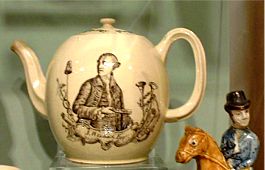 This
rather charming Creamware teapot, c1775, has a metal capped spout and decorated
with a seated fox. The teapot was made by William Greatbatch, Fenton, Staffordshire.
The decoration of the fox has an inscription below it of 'Beware of the Fox', this
referring to drunkenness!
This
rather charming Creamware teapot, c1775, has a metal capped spout and decorated
with a seated fox. The teapot was made by William Greatbatch, Fenton, Staffordshire.
The decoration of the fox has an inscription below it of 'Beware of the Fox', this
referring to drunkenness!
The next teapot that caught my eye was this one made at 'Cockpit hill', Derby. One side of the teapot is printed with Britannia, the other side with a portrait, signed by Thomas Radford, of the controversial MP John Wilkes (1727-97), regarded as a champion of free speech.
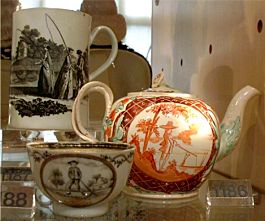 Within
the section devoted to sport and Leisure activities is a lovely set of items showing
people fishing. The teapot here was made in Liverpool (it has a replacement lid)
and is beautifully decorated on each side with a man fishing beside a river. Not
only was fishing a gentleman's sport as can be seen from the mug, c1765. This mug
is made of soft-paste porcelain and originates from the famous Worcester factory.
Printed on one side is a scene showing fortune telling and on the other with ladies
fishing, known as the 'Whitton Anglers'.
Within
the section devoted to sport and Leisure activities is a lovely set of items showing
people fishing. The teapot here was made in Liverpool (it has a replacement lid)
and is beautifully decorated on each side with a man fishing beside a river. Not
only was fishing a gentleman's sport as can be seen from the mug, c1765. This mug
is made of soft-paste porcelain and originates from the famous Worcester factory.
Printed on one side is a scene showing fortune telling and on the other with ladies
fishing, known as the 'Whitton Anglers'.
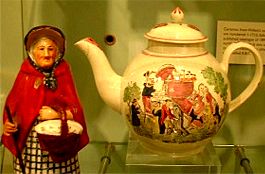
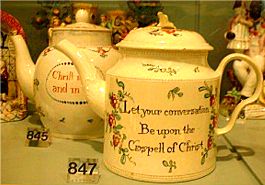 A
Pearlware teapot, made c1800 by John Aynsley, Lane End, Staffordshire, shows a printed
scene of women climbing into a milling machine and is inscribed with 'Old women
ground young'.
A
Pearlware teapot, made c1800 by John Aynsley, Lane End, Staffordshire, shows a printed
scene of women climbing into a milling machine and is inscribed with 'Old women
ground young'.
One of the twenty three categories of the collections is religion. The teapot found here is of enamelled Creamware and made by William Greatbatch, Fenton, Staffordshire. It is painted with Chinese figures and inscribed 'Let your conversation Be upon the Gospel of Christ'.
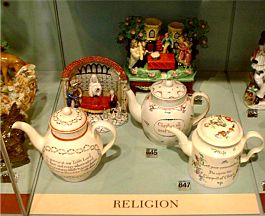
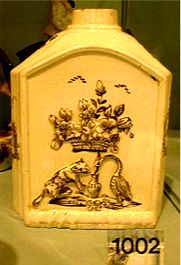
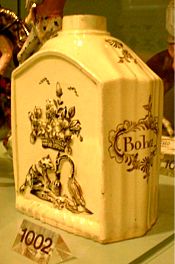 A
large Creamware tea canister, c1780 is a lovely item in the collection. It is beautifully
relief moulded with a scene from one of Aesop's fables, this particular one of the
'Fox and the Crane'. On the side of the canister it is painted with the word 'Bohea'
describing the tea content.
A
large Creamware tea canister, c1780 is a lovely item in the collection. It is beautifully
relief moulded with a scene from one of Aesop's fables, this particular one of the
'Fox and the Crane'. On the side of the canister it is painted with the word 'Bohea'
describing the tea content.
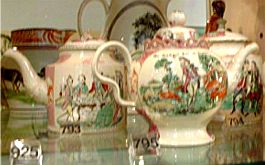
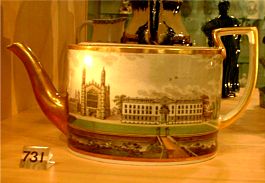 Another
teapot by William Greatbatch is printed and enamelled with an episode from the parable
'The Prodigal Son in Misery'.
Another
teapot by William Greatbatch is printed and enamelled with an episode from the parable
'The Prodigal Son in Misery'.
One teapot, which has the most amazing painted decoration, is this fine one made by Minton, Stoke-on-Trent, c1805. The oval bodied teapot is of soft-paste porcelain and the exquisite painting is of Kings Chapel and Clare Hall in Cambridge-still very much a recognisable view today.
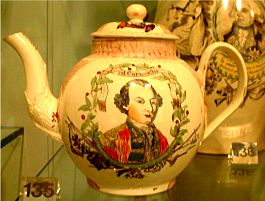
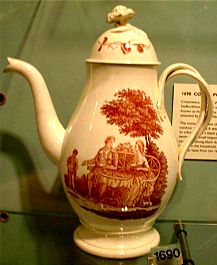 A
Creamware teapot, c1781, depicts Lord Cornwallis (1738-1805) and some British troops
in America. This fabulous teapot was made by William Greatbatch.
A
Creamware teapot, c1781, depicts Lord Cornwallis (1738-1805) and some British troops
in America. This fabulous teapot was made by William Greatbatch.
Moving away from teapots, I saw this handsome coffee pot. Made at the famous Wedgwood factory in Etruria, Staffordshire, it is decorated with an outdoor scene known as the 'Tea Party'. The tea drinkers are attended by a young black page. This coffee pot is in a category depicting black people in British history.
The scene shows one of the many variations of the tea party. A wealthy man and lady sit in an arbour while a black page pours water from a kettle into a teapot. The group reflects the use of the young black domestic servant as a status symbol in the household, a notion which prevailed, in art at least, from the sixteenth to the eighteenth centuries.
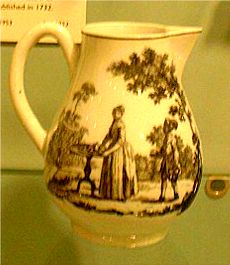 A
similar notion is displayed on this pretty Worcester milk jug, c1760. This is printed
with a design, probably the work of Robert Hancock. The design is of the tea party
and a maid preparing a tea table with a little black boy carrying a kettle. The
image of the maid is taken from an engraving by Gravelot after Quadrille (1743),
one of Frances Hayman's decorative paintings of 1743 executed for the supper boxes
in the Vauxhall Pleasure Gardens. The exotically dressed page derives from Plate
11 of Hogarth's 'A Harlot's Progress' published in 1732.
A
similar notion is displayed on this pretty Worcester milk jug, c1760. This is printed
with a design, probably the work of Robert Hancock. The design is of the tea party
and a maid preparing a tea table with a little black boy carrying a kettle. The
image of the maid is taken from an engraving by Gravelot after Quadrille (1743),
one of Frances Hayman's decorative paintings of 1743 executed for the supper boxes
in the Vauxhall Pleasure Gardens. The exotically dressed page derives from Plate
11 of Hogarth's 'A Harlot's Progress' published in 1732.
On that note, I made progress from the exhibition, which I enjoyed immensely, to take tea in the 'Gallery Café', situated within the museum. I do hope that you have enjoyed the small sample of delights to be discovered in this wonderful museum and exhibition and have a chance to visit it yourself.
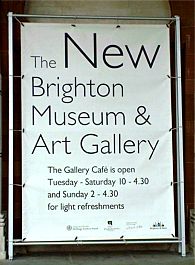
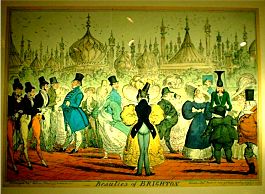 Brighton
Museum & Art Gallery
Brighton
Museum & Art Gallery
The Royal Pavilion Gardens
Brighton
Tel: 01273 290900
www.brightonmuseums.org.uk/brighton/
Click here for
Local Map
Map courtesy of www.streetmap.co.uk
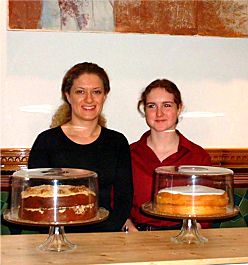
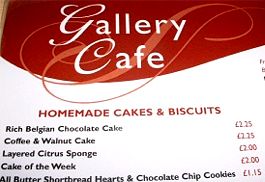 A
very warm welcome with smiles awaits visitors to the the 'Gallery Café' within Brighton
Museum. Having enjoyed the museum exhibitions, I was in for an extra treat in taking
a wonderful afternoon tea in the Café there. The 'Gallery Café', so called as it
is situated up on a gallery from where you can sit and enjoy views over on of the
museum galleries which contains early twentieth century furnishings.
A
very warm welcome with smiles awaits visitors to the the 'Gallery Café' within Brighton
Museum. Having enjoyed the museum exhibitions, I was in for an extra treat in taking
a wonderful afternoon tea in the Café there. The 'Gallery Café', so called as it
is situated up on a gallery from where you can sit and enjoy views over on of the
museum galleries which contains early twentieth century furnishings.
The Gallery Café, like the museum has a new and modern feel to it. There is a counter upon which is displayed the home-made cakes available on the menu. The furniture is smart and comfortable. From my table I had a chance to view the museum gallery below and to sit and take in all that I had viewed in the stunning new porcelain gallery.
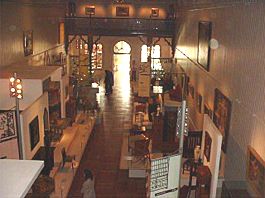
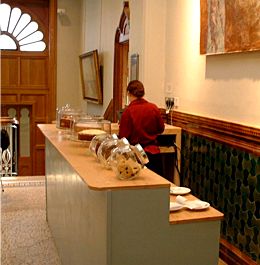
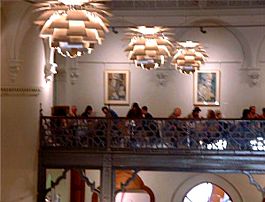
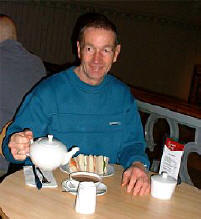
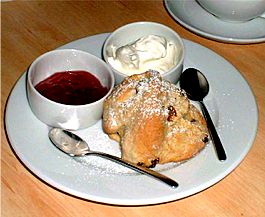 I
was very impressed with the friendly and attentive service that I received in the
Café. I ordered the full High Tea, which I am pleased to say was really delightful.
The tea comprised a set of four quarter sandwiches, two of smoked salmon and two
of cucumber with soft cream cheese. These were freshly made with white bread on
one side and brown on the other side of each sandwich, giving them a colourful and
decorative appearance.
I
was very impressed with the friendly and attentive service that I received in the
Café. I ordered the full High Tea, which I am pleased to say was really delightful.
The tea comprised a set of four quarter sandwiches, two of smoked salmon and two
of cucumber with soft cream cheese. These were freshly made with white bread on
one side and brown on the other side of each sandwich, giving them a colourful and
decorative appearance.
Following the sandwiches was a home-made fruit scone. This was delicious, warm and soft textured on the inside with a crisp outside crust. Presented with the scone was a dish of strawberry jam and lightly whipped cream. It is always a treat to go to a Café where the scones are fresh and home-made, like these were, it makes all the difference!
Finally, I selected to have the layered lemon sponge, again fresh and home-made. This, like the rest of the fare was wonderful, light rich sponge sandwiched with two layers of tangy lemon curd and topped with sweet water icing.
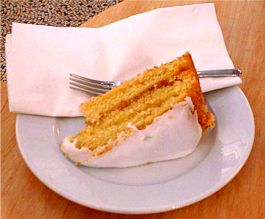
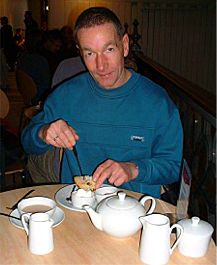
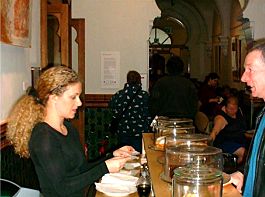
Having enjoyed the afternoon tea, I was informed by the friendly and extremely pleasant owner, Heather Tomlinson, that she prided herself in being one of only a few places in Brighton where a traditional full afternoon tea could still be enjoyed. It was obvious that she had a great pride and passion in her service and quality of food that she offered. Even better news is that she has another Café within neighbouring Hove Museum, I cannot wait to visit the museum and to report on her Café there - watch this space!
Certainly, the Gallery Café is well worth a visit if ever you find yourself Regency Brighton.
Gallery Café
Brighton Museum & Art Gallery
Brighton
BN1 1EE
Tel: 01273 292814
Click here for
Local Map
Map courtesy of www.streetmap.co.uk
To review past newsletters, just follow this link:
Past newsletters.
To subscribe to this free newsletter -
Click here